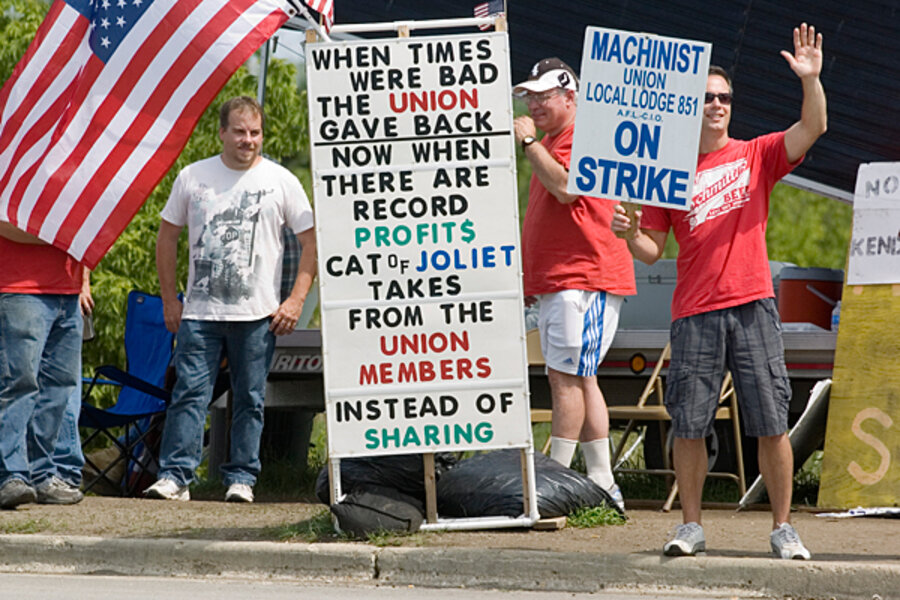With end of long strike at Caterpillar, a blow to US labor movement
Loading...
| Chicago
The end of a machinists' strike at Caterpillar Inc., after a 3-1/2-month standoff, not only points to the weakened state of the American labor movement, but also bodes poorly for the manufacturing worker – even those in high-skill jobs that many say are the future of manufacturing in the US.
The bitter strike ended Friday, as workers at a plant in Joliet, Ill., agreed to numerous concessions, including a virtual pay freeze. Members of the International Association of Machinists and Aerospace Workers had been on strike against Caterpillar, one of the world’s largest heavy equipment manufacturers, since May 1.
“It’s one more small piece of evidence that the lower half of the income distribution is struggling while the people at the very top are faring quite well,” says Richard Hurd, a professor of labor studies at Cornell University in Ithaca, N.Y.
The workers agreed to concessions that have become familiar in labor negotiations throughout American manufacturing. The six-year contract froze pay for older and higher-paid workers and granted a 3 pecent raise for newer, lower-paid workers. Like many manufacturers, Caterpillar pays newer workers at a lower wage scale than older workers. Workers at the Joliet plant, which builds hydraulic components for heavy machinery, earn wages ranging from $11.50 to $28 an hour.
Workers also agreed to Caterpillar’s demand that they pay more for their health insurance and switch from a defined benefit pension plant to 401(k)s. Each worker will receive a $3,100 bonus for ratifying a new contract.
The machinists’ defeat suggests that “wages in manufacturing will be flat in the foreseeable future,” says Michael LeRoy, a professor of labor relations at the University of Illinois at Urbana-Champaign.
Analysts say they were surprised by one twist in the dispute: The concessions were demanded not by a company struggling to survive, as US auto makers were in 2008 and 2009 when auto workers agreed to concessions to help keep American car manufacturing afloat, but by a thriving firm. Indeed, Caterpillar is earning record profits, including a profit of $1.7 billion in the second quarter of this year, 67 percent higher than a year ago. Last year top executives also received hefty raises.
The machinists had previously rejected two offers from Caterpillar, but the strike’s length had begun to wear them down. About 780 workers went on strike, and union officials conceded that more than 100 had since crossed the picket line to return to work. Striking workers had received $150 a week in strike benefits from the union.
Caterpillar has been described as a hard-nosed negotiator in labor relations. Experts say it wasn’t always so. Until the 1980s, the company enjoyed fairly amicable relations with workers, says Mr. LeRoy. But the company suffered a long slump and emerged as a much more “aggressive” company, he says. In the 1990s, it fought the United Auto Workers Union – and won. Early this year, Caterpillar shut down a plant in London, Ontario, in a labor dispute that cost 450 workers their jobs.
Caterpillar argued that it needed to reduce labor costs because of the possibility of more difficult times in the future. But such arguments “don’t stand up to logical analysis,” says Robert Bruno, professor of labor and employment relations at University of Illinois at Urbana-Champaign. In that case, he says, workers would never share in their companies’ prosperity.
Caterpillar did not return messages Friday asking for comment.
Through many of the most prosperous years of American manufacturing, beginning in the 1950s, there was a “strong linkage” between the well being of workers and the prosperity of the companies they worked for, Mr. Bruno says. Workers prospered when their companies did, and they accepted concessions when their companies faltered.
“It was a path to social mobility and into the middle class,” he says.
That link is broken now, he says.
Strikes have become rare in the United States and now number in the dozens, instead of hundreds in past decades. Today only about 7 percent of workers in the private sector are unionized, compared with 35 percent in the 1950s.
“Workers have this sense that there’s a larger dynamic that’s playing out,” says Bruno. “If you cant wage a good battle and get a good contract now, when will you get one? In that sense, this is their last stand.”
Tim Flaherty, the plant manager in Joliet, said in a written statement that Caterpillar is happy that the strike has ended and that employees are returning to work. "I think everyone involved is ready to get this behind us," he said.
Workers who had gathered Friday morning at a union hall on the edge of Joliet, a working-class city just south of Chicago, to vote on the new contract endured an intense, emotional meeting that lasted several hours. Many workers left feeling angry and exhausted.
“I’m very disappointed,” said Sean Gallaway, who has worked at Caterpillar for 17 years and who voted against the new contract. “But we live in a democratic society, so I’m going to go with what the majority says.”
Although he's unhappy about how the strike ended, Mr. Gallaway says he'll be "glad to go back to work."







